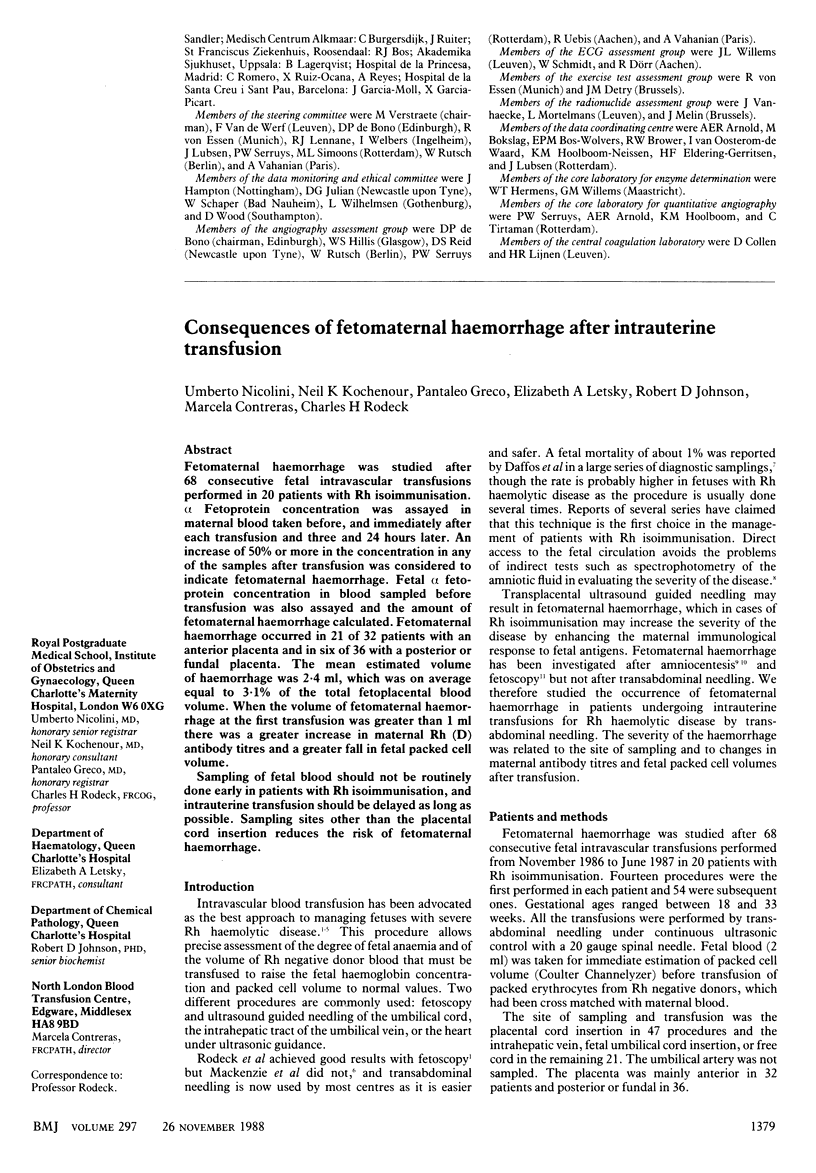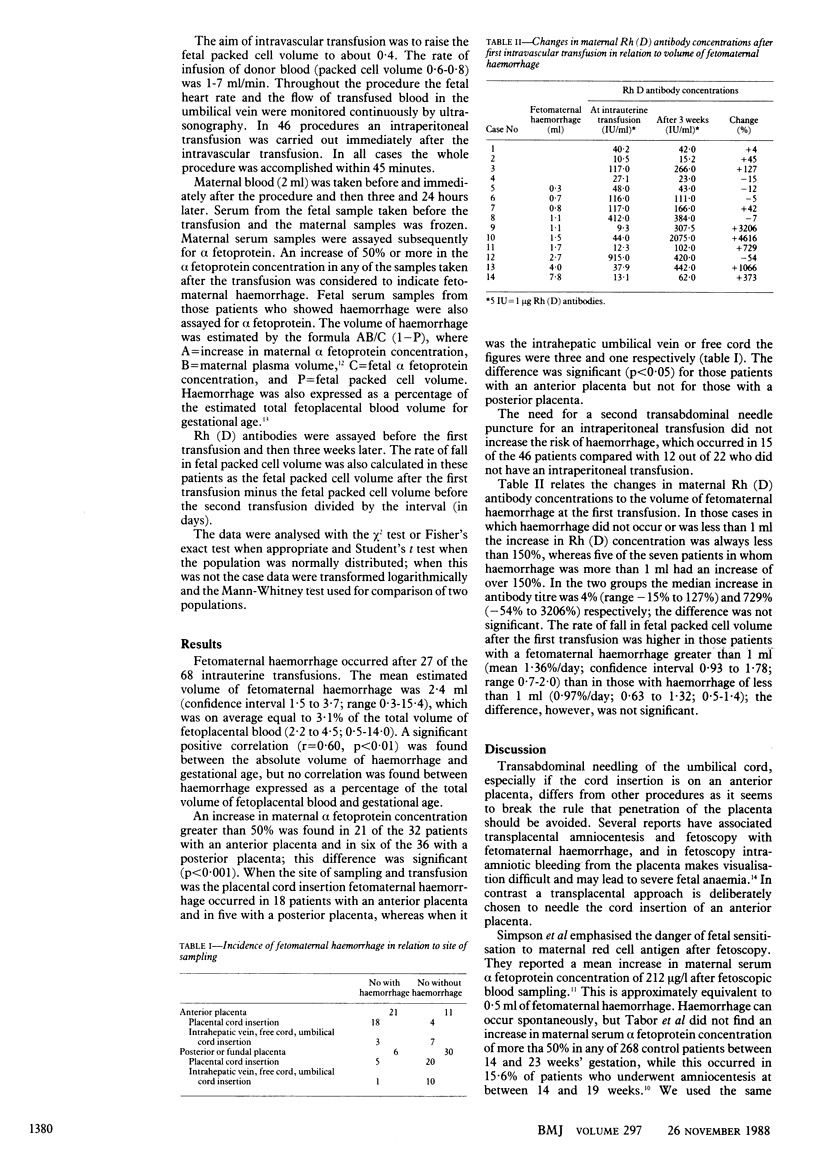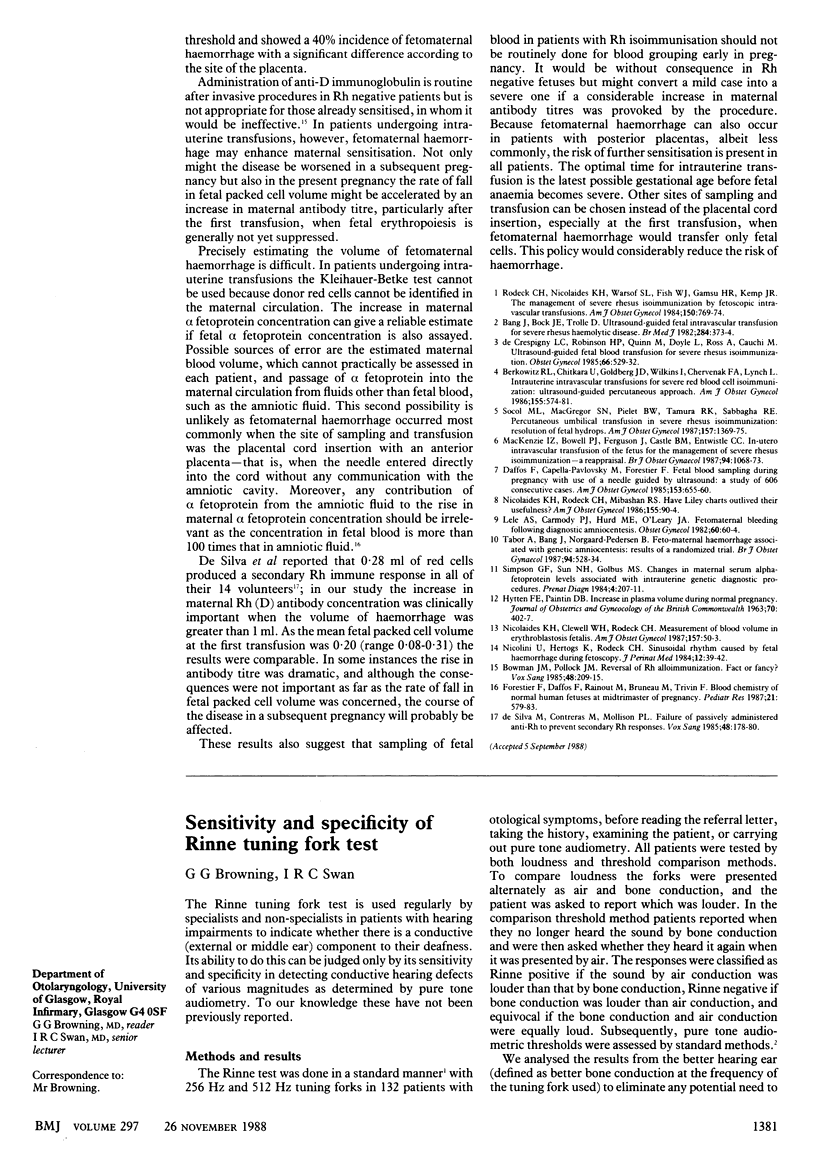Abstract
Fetomaternal haemorrhage was studied after 68 consecutive fetal intravascular transfusions performed in 20 patients with Rh isoimmunisation. alpha Fetoprotein concentration was assayed in maternal blood taken before, and immediately after each transfusion and three and 24 hours later. An increase of 50% or more in the concentration in any of the samples after transfusion was considered to indicate fetomaternal haemorrhage. Fetal alpha fetoprotein concentration in blood sampled before transfusion was also assayed and the amount of fetomaternal haemorrhage calculated. Fetomaternal haemorrhage occurred in 21 of 32 patients with an anterior placenta and in six of 36 with a posterior or fundal placenta. The mean estimated volume of haemorrhage was 2.4 ml, which was on average equal to 3.1% of the total fetoplacental blood volume. When the volume of fetomaternal haemorrhage at the first transfusion was greater than 1 ml there was a greater increase in maternal Rh (D) antibody titres and a greater fall in fetal packed cell volume. Sampling of fetal blood should not be routinely done early in patients with Rh isoimmunisation, and intrauterine transfusion should be delayed as long as possible. Sampling sites other than the placental cord insertion reduces the risk of fetomaternal haemorrhage.
Full text
PDF


Selected References
These references are in PubMed. This may not be the complete list of references from this article.
- Bang J., Bock J. E., Trolle D. Ultrasound-guided fetal intravenous transfusion for severe rhesus haemolytic disease. Br Med J (Clin Res Ed) 1982 Feb 6;284(6313):373–374. doi: 10.1136/bmj.284.6313.373. [DOI] [PMC free article] [PubMed] [Google Scholar]
- Berkowitz R. L., Chitkara U., Goldberg J. D., Wilkins I., Chervenak F. A., Lynch L. Intrauterine intravascular transfusions for severe red blood cell isoimmunization: ultrasound-guided percutaneous approach. Am J Obstet Gynecol. 1986 Sep;155(3):574–581. doi: 10.1016/0002-9378(86)90282-6. [DOI] [PubMed] [Google Scholar]
- Daffos F., Capella-Pavlovsky M., Forestier F. Fetal blood sampling during pregnancy with use of a needle guided by ultrasound: a study of 606 consecutive cases. Am J Obstet Gynecol. 1985 Nov 15;153(6):655–660. doi: 10.1016/s0002-9378(85)80254-4. [DOI] [PubMed] [Google Scholar]
- Forestier F., Daffos F., Rainaut M., Bruneau M., Trivin F. Blood chemistry of normal human fetuses at midtrimester of pregnancy. Pediatr Res. 1987 Jun;21(6):579–583. doi: 10.1203/00006450-198706000-00015. [DOI] [PubMed] [Google Scholar]
- HYTTEN F. E., PAINTIN D. B. Increase in plasma volume during normal pregnancy. J Obstet Gynaecol Br Emp. 1963 Jun;70:402–407. doi: 10.1111/j.1471-0528.1963.tb04922.x. [DOI] [PubMed] [Google Scholar]
- Lele A. S., Carmody P. J., Hurd M. E., O'Leary J. A. Fetomaternal bleeding following diagnostic amniocentesis. Obstet Gynecol. 1982 Jul;60(1):60–64. [PubMed] [Google Scholar]
- Mackenzie I. Z., Bowell P. J., Ferguson J., Castle B. M., Entwistle C. C. In-utero intravascular transfusion of the fetus for the management of severe Rhesus isoimmunization--a reappraisal. Br J Obstet Gynaecol. 1987 Nov;94(11):1068–1073. doi: 10.1111/j.1471-0528.1987.tb02291.x. [DOI] [PubMed] [Google Scholar]
- Nicolaides K. H., Clewell W. H., Rodeck C. H. Measurement of human fetoplacental blood volume in erythroblastosis fetalis. Am J Obstet Gynecol. 1987 Jul;157(1):50–53. doi: 10.1016/s0002-9378(87)80344-7. [DOI] [PubMed] [Google Scholar]
- Nicolaides K. H., Rodeck C. H., Mibashan R. S., Kemp J. R. Have Liley charts outlived their usefulness? Am J Obstet Gynecol. 1986 Jul;155(1):90–94. doi: 10.1016/0002-9378(86)90085-2. [DOI] [PubMed] [Google Scholar]
- Nicolini U., Hertogs K., Rodeck C. H. Sinusoidal rhythm caused by fetal hemorrhage during fetoscopy. J Perinat Med. 1984;12(1):39–42. [PubMed] [Google Scholar]
- Rodeck C. H., Nicolaides K. H., Warsof S. L., Fysh W. J., Gamsu H. R., Kemp J. R. The management of severe rhesus isoimmunization by fetoscopic intravascular transfusions. Am J Obstet Gynecol. 1984 Nov 15;150(6):769–774. doi: 10.1016/0002-9378(84)90683-5. [DOI] [PubMed] [Google Scholar]
- Simpson G. F., Sun N. H., Golbus M. S. Changes in maternal serum alpha-fetoprotein levels associated with intrauterine genetic diagnostic procedures. Prenat Diagn. 1984 May-Jun;4(3):207–211. doi: 10.1002/pd.1970040308. [DOI] [PubMed] [Google Scholar]
- Socol M. L., MacGregor S. N., Pielet B. W., Tamura R. K., Sabbagha R. E. Percutaneous umbilical transfusion in severe rhesus isoimmunization: resolution of fetal hydrops. Am J Obstet Gynecol. 1987 Dec;157(6):1369–1375. doi: 10.1016/s0002-9378(87)80226-0. [DOI] [PubMed] [Google Scholar]
- Tabor A., Bang J., Nørgaard-Pedersen B. Feto-maternal haemorrhage associated with genetic amniocentesis: results of a randomized trial. Br J Obstet Gynaecol. 1987 Jun;94(6):528–534. doi: 10.1111/j.1471-0528.1987.tb03145.x. [DOI] [PubMed] [Google Scholar]
- de Crespigny L. C., Robinson H. P., Quinn M., Doyle L., Ross A., Cauchi M. Ultrasound-guided fetal blood transfusion for severe rhesus isoimmunization. Obstet Gynecol. 1985 Oct;66(4):529–532. [PubMed] [Google Scholar]
- de Silva M., Contreras M., Mollison P. L. Failure of passively administered anti-Rh to prevent secondary Rh responses. Vox Sang. 1985;48(3):178–180. doi: 10.1111/j.1423-0410.1985.tb00167.x. [DOI] [PubMed] [Google Scholar]


